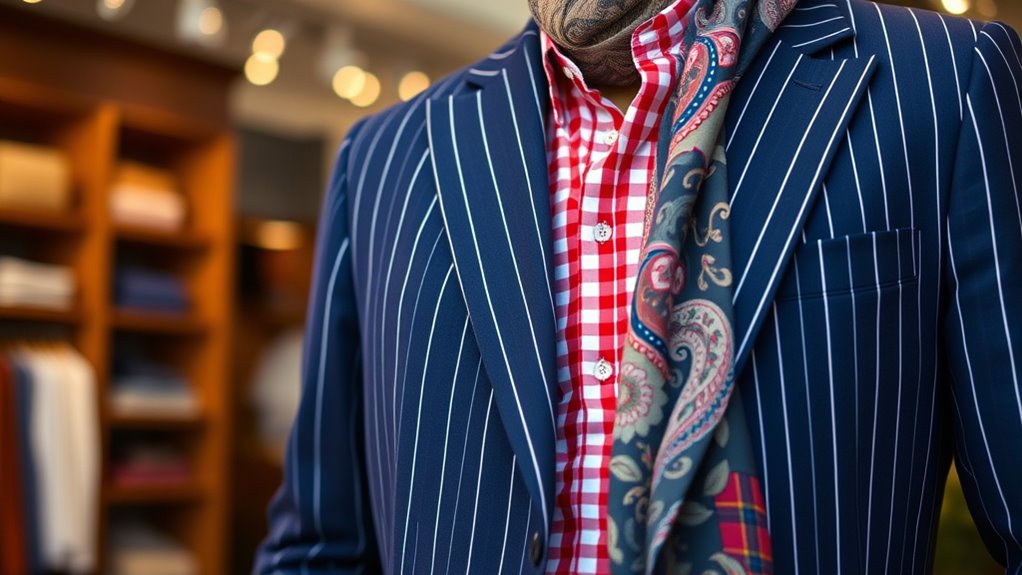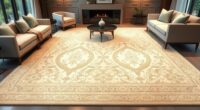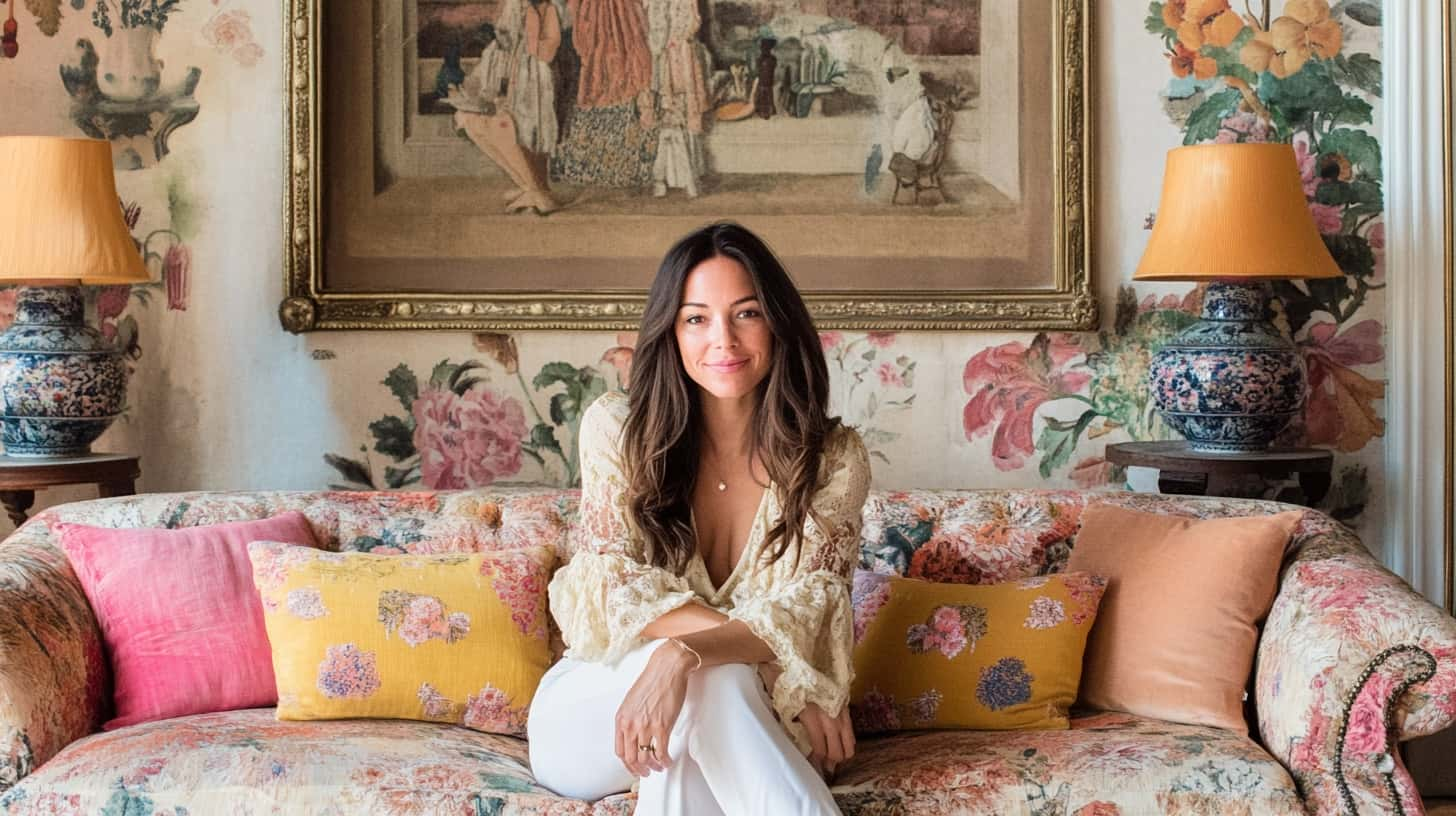To mix and match patterns like a pro, start by identifying different styles such as florals, stripes, or geometric prints, and pair larger with smaller patterns using a cohesive color palette. Balance bold prints with subtle ones and use neutral accessories to prevent clutter. Focus on scale, contrast, and harmony, keeping your outfit simple and well-coordinated. Keep exploring these tips to elevate your pattern-matching game even more.
Key Takeaways
- Combine contrasting patterns, such as floral with stripes, for visual interest while maintaining a cohesive color palette.
- Balance large-scale patterns with smaller ones, pairing bold prints with subtle designs.
- Use neutral accessories and clothing to break up busy patterns and create harmony.
- Limit pattern mixes to two or three items to avoid overwhelming the look.
- Coordinate colors using a dominant hue and incorporate neutrals to ground and unify the ensemble.
Understanding Pattern Types and How to Combine Them

Understanding pattern types is essential before you start mixing and matching them. Recognizing the different styles helps you create balanced, eye-catching outfits. For example, floral patterns are often bold and busy, while stripes tend to be more structured. Mixing large-scale patterns with smaller ones works well if you keep a consistent color palette, so they don’t clash. When combining patterns, think of contrast and harmony—pair a geometric with a softer floral to add interest without overwhelming. You can also mix similar patterns at different scales for a subtle effect. Remember, the key is to find a balance: don’t match everything exactly, but ensure your patterns complement each other. Being aware of relationship dynamics can help you understand how to create visual harmony in your outfits. With a clear understanding of pattern types, you’ll confidently craft stylish, cohesive looks.
Mastering the Art of Color Coordination
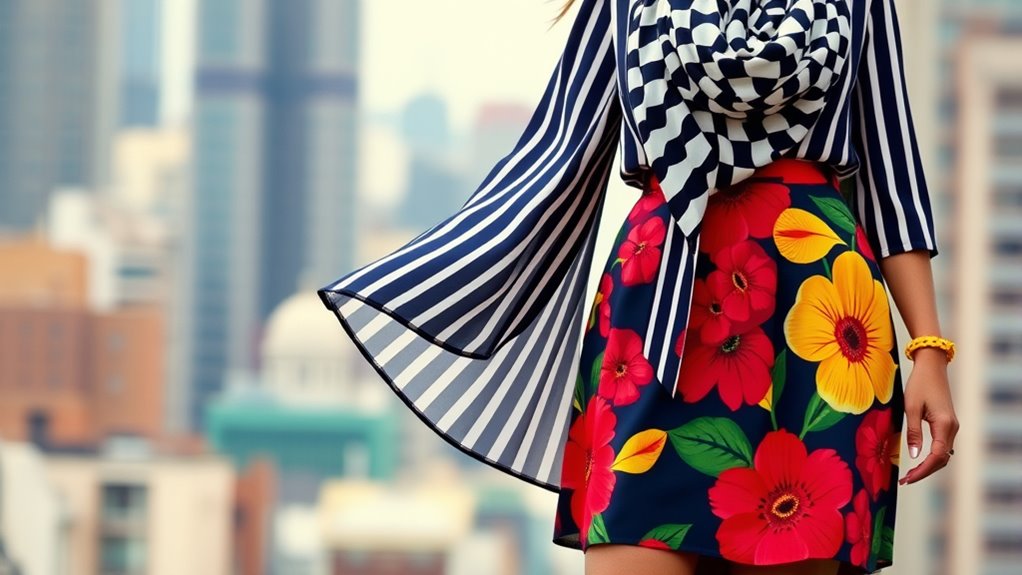
Mastering the art of color coordination is essential for creating visually appealing outfits that stand out. You want your patterns to complement each other, not clash. Start by choosing a dominant color and build your outfit around it. Use a color wheel to identify complementary, analogous, or monochromatic schemes that work well together. Keep your palette simple—two or three main colors—to avoid overwhelming the eye. Incorporate neutral tones like black, white, or beige to balance bold hues. Pay attention to the intensity of colors; mixing bright with muted shades creates harmony. Remember, confidence is key. When your colors are thoughtfully coordinated, your patterns will pop without competing, giving you a polished, stylish look effortlessly. Color harmony plays a crucial role in ensuring your outfit looks cohesive and visually appealing. Additionally, understanding fashion trends can help you stay current and make better pattern mixing choices. Recognizing visual balance can also help you create outfits that feel harmonious and well-composed. Incorporating proper color matching techniques can further elevate your pattern combination skills. To enhance your understanding, consider exploring the bedroom decorating principles that emphasize balance and harmony, which are also vital in fashion coordination.
Playing With Scale: Balancing Bold and Subtle Prints

Balancing bold and subtle prints is essential to creating an outfit that’s eye-catching yet harmonious. When mixing patterns, consider the scale of each print. Larger, bold patterns draw attention, while smaller, subtle prints add depth without overwhelming. To master this balance, keep these tips in mind:
- Pair a large, statement print with a smaller, understated pattern.
- Use neutral or solid-colored accessories to break up busy prints.
- Vary the scale within the same outfit to create visual interest.
- Limit yourself to two or three different patterns to avoid clutter.
- Incorporating textures and fabrics can further enhance the layered look and add tactile dimension.
- Employing a cohesive color palette helps unify diverse patterns, creating a more polished appearance.
- Developing a creative practice by experimenting with different combinations can help refine your pattern mixing skills and foster a more intuitive sense of balance.
- Understanding beach destinations and their unique environments can inspire you to select patterns and colors that reflect the local scenery and vibe.
Incorporating Neutral Tones to Ground Your Outfits
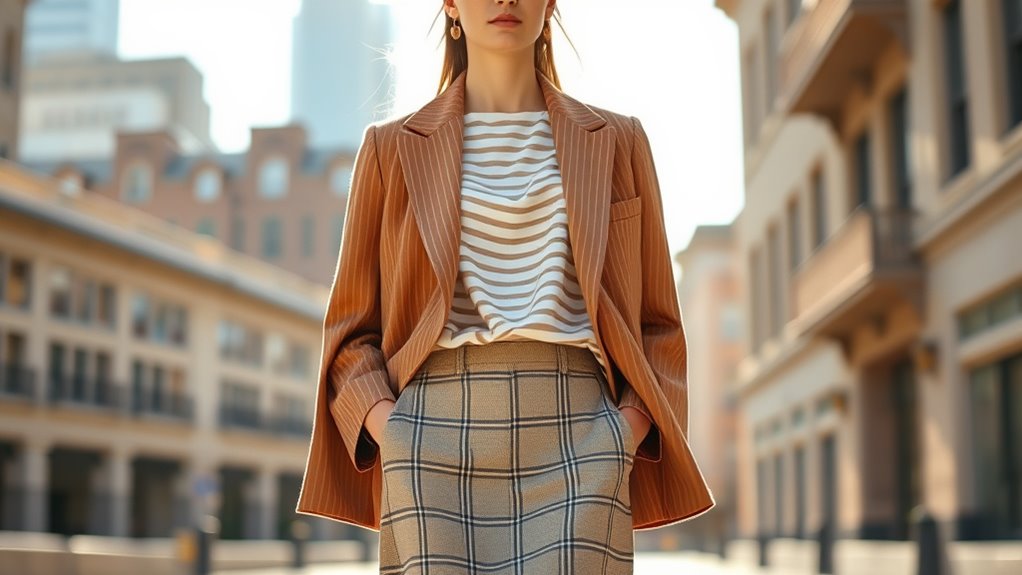
Incorporating neutral tones into your outfits helps create a calm, cohesive foundation that allows other patterns and colors to stand out. Neutrals like beige, taupe, gray, and white are versatile and easy to incorporate. They act as a balancing backdrop, preventing your look from feeling overwhelming when mixing multiple patterns. For example, a neutral-colored blazer or pants can anchor a vibrant patterned shirt or skirt. Neutral tones also make layering simpler, giving your outfit a polished, sophisticated vibe. When you use neutrals as a base, you can experiment with bolder patterns and colors on top, knowing they won’t clash. This approach helps you build a well-balanced, stylish ensemble that feels effortless yet put-together. Additionally, understanding color harmony can enhance your ability to combine patterns and neutrals seamlessly. Recognizing how neutral tones function within different color schemes can further improve your styling versatility. Exploring self-awareness into your wardrobe choices can help you identify which neutral shades complement your personal style and complexion. Incorporating an understanding of pinball history can inspire a playful approach to mixing textures and patterns, adding depth to your outfits.
Tips for Accessorizing Patterned Looks
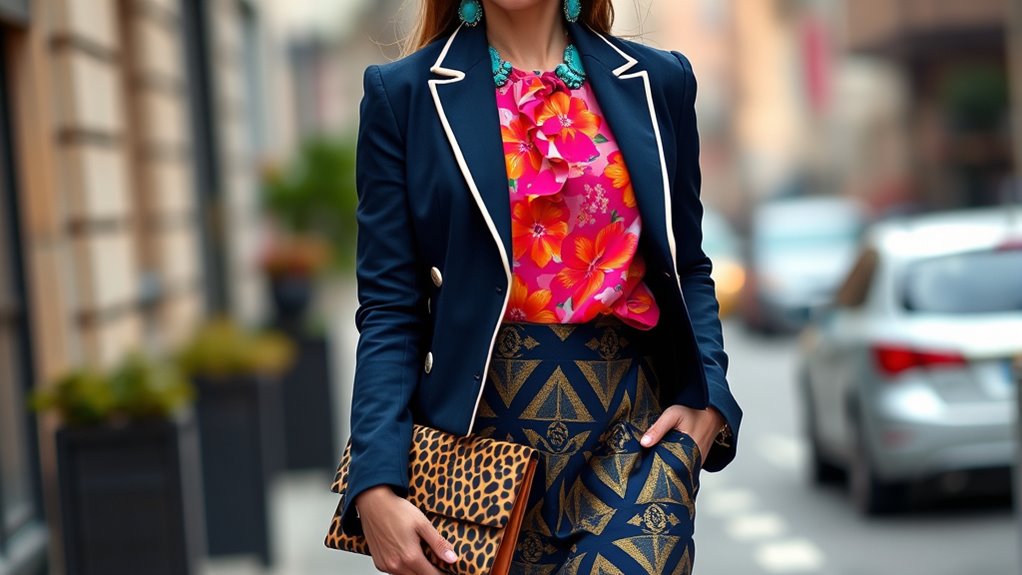
When accessorizing patterned looks, choosing the right pieces can elevate your outfit without overwhelming it. The goal is to add interest without clashing. Here are some tips:
- Opt for solid-colored accessories to balance busy patterns.
- Keep jewelry simple—think delicate necklaces or small earrings.
- Use neutral bags and shoes to avoid competing with your outfit’s patterns.
- Consider minimalistic scarves or hats that complement your color palette.
- Incorporate self watering plant pots to add a touch of greenery and texture to your look, especially when styling an outdoor or natural-inspired ensemble. Adding natural elements can also create a harmonious connection with the environment, much like sustainable wood-burning practices promote eco-friendliness.
- Incorporating subtle energy awareness, such as spiritual energy, into your styling can help you feel more centered and confident in your outfit choices. Additionally, understanding the importance of trustworthiness of Patchology in skincare can inspire you to choose accessories that reflect quality and authenticity, enhancing your overall confidence.
These choices help create harmony and ensure your accessories enhance rather than distract from your look. Remember, less is often more when pattern mixing, so select pieces that support your overall style without overpowering it.
Frequently Asked Questions
How Do I Mix Patterns for Formal Versus Casual Occasions?
You want to know how to mix patterns for different occasions. For formal events, keep it classy by pairing subtle patterns like pinstripes or small polka dots with solid colors. For casual outings, feel free to mix bold patterns like florals and stripes, balancing them with neutral accessories. Always consider scale and color harmony, so your look stays polished or relaxed, depending on the event.
What Are Common Mistakes to Avoid When Pairing Patterns?
When pairing patterns, you want to avoid common mistakes like mixing too many bold prints, which can look chaotic. Steer clear of clashing colors or patterns with different scales that don’t complement each other. Don’t forget to keep the overall look balanced—if one piece is busy, tone down the others. Ultimately, avoid ignoring your personal style; your outfit should reflect your taste, not just trends.
Can I Mix More Than Three Patterns in One Outfit?
Imagine stepping out in an outfit bursting with energy—can you really pull off more than three patterns? Yes, you can! The trick is balancing scale and color, making sure patterns complement instead of clash. Start with a dominant pattern, then add smaller, subtler ones. When done right, your look becomes a bold, stylish statement, showing confidence and creativity. So go ahead—dare to mix more for a truly eye-catching ensemble.
How Do Patterns Suit Different Skin Tones and Hair Colors?
When choosing patterns, consider your skin tone and hair color to enhance your look. You’ll want to pick colors that complement your complexion; warm tones suit golden or olive skin, while cool tones work well with fair or rosy skin. Bright patterns can make dark hair pop, while softer patterns suit lighter hair. Trust your instincts and try different combinations to see what makes you feel confident and radiant.
Are There Specific Patterns That Should Never Be Paired Together?
Ever wonder if some patterns just shouldn’t be paired? You should avoid combining busy patterns with intricate, small-scale prints, as it can create visual chaos. Also, steer clear of mixing floral with bold geometric prints unless you want a clash. Instead, balance patterns by pairing a statement print with a more subtle one. Keep it simple, confident, and remember, sometimes less truly is more.
Conclusion
Now you’re ready to conquer the world of patterns like a true styling maestro! With these tips, your outfits will turn heads and make jaws drop—seriously, you’ll be unstoppable. Remember, mixing patterns is an art, so don’t be afraid to experiment and let your personal style shine through. Embrace the boldness, have fun, and watch as your wardrobe becomes the most talked-about collection in the entire universe!
